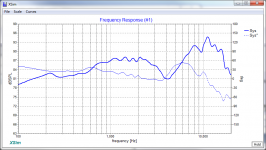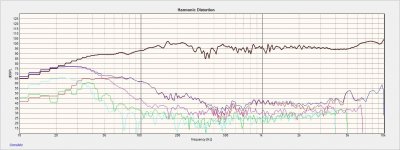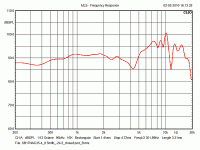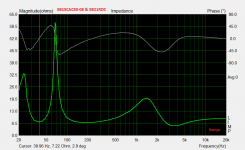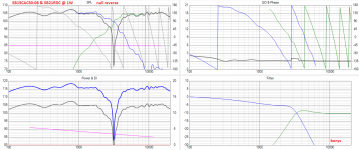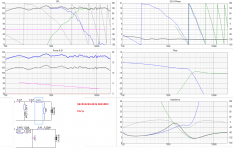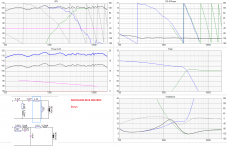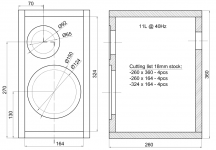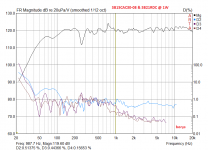Not sure what you're looking at but the on-axis frequency response is very good up to 4 kHz or so, with the only flaw being a mild, broad rise centered at 1.5-2 kHz.
If you're talking about the 30 and 60 degree off-axis curves, they seem to be fairly in-line with other drivers of similar size. I have not, however, double-checked to confirm...
If you put the driver on a narrow baffle of a typical size of about 200mm, there is usually a dip around 3 - 4khz due to diffraction. On the infinite baffle, the driver starts to taper beginning at 2khz then dips at around 3khz, then starts to break up after that so generously after 3khz, it is no longer usable. So if you combine the diffraction dip and the inherent dip of the driver on the actual baffle, it does start to taper off rather quickly after 2khz. I have the actual freq. measurement on a 200mm baffle which is posted below. As you can see, realistically on a 200mm x 300mm baffle, one should design a xover that start to roll off after 2khz.
I mean if you use aggresive 24db roll off, I guess it could be done, but still the mid is still the mid.
Attachments
Last edited:
I was going to stay out of this discussion but its getting really goofy and filled with misinformation. The following measurements were taken by a DIY friend (powerider) that I've known for several years and has demonstrated his measurement and crossover skills at many DIY events over the years. His measurements follow Zaph's for consistancy.
Here you go...
BTW, his project is nearing completion and he says the mid-range is superb.
HTH
Jim
Here you go...
BTW, his project is nearing completion and he says the mid-range is superb.
HTH
Jim
Attachments
Last edited:
I was going to stay out of this discussion but its getting really goofy and filled with misinformation. The following measurements were taken by a DIY friend (powerider) that I've known for several years and has demonstrated his measurement and crossover skills at many DIY events over the years. His measurements follow Zaph's for consistancy.
Here you go...
BTW, his project is nearing completion and he says the mid-range is superb.
HTH
Jim
You are using super tiny 5db/div and not only that you stretch out the horizontal axis so it will make any driver looks good. The graph shows the same dip as on my graph but the 5db/div makes it looks a lot better. There is not that much difference between yours and my plot.
That's why he uses 24db roll off. As I said a couple times, using 24db roll off may work out, but I am not sure it will fix the mid as far as the CAC is concerned.
You are using super tiny 5db/div and not only that you stretch out the horizontal axis so it will make any driver looks good. The graph shows the same dip as on my graph but the 5db/div makes it looks a lot better. There is not that much difference between yours and my plot.
You need to look closer at the data. Your plot shows a 6 dB dip. My measurement that Jim posted shows only a 3 dB dip. A different scale on either or both axis may make a plot look subjectively better or worse, but the data stands on its own. Your data does not match my data.
You need to look closer at the data. Your plot shows a 6 dB dip. My measurement that Jim posted shows only a 3 dB dip. A different scale on either or both axis may make a plot look subjectively better or worse, but the data stands on its own. Your data does not match my data.
That is true. My baffle geometry has a more severe dip at around 4khz due to diffraction. No driver will have the same exact measurement on two different baffles. Unless that is what you're saying? I am looking at the general freq. profile of the driver. The actual absolute magnitude is all relative.
Last edited:
strange, I can't see alot wrong with these drivers... I can't hear anything wrong with them either.
That is true. My baffle geometry has a more severe dip at around 4khz due to diffraction. No driver will have the same exact measurement on two different baffles. Unless that is what you're saying? I am looking at the general freq. profile of the driver. The actual absolute magnitude is all relative.
This doesn't add up. I simulated a 200 mm wide x 300 mm tall baffle, with sharp edges, and a 120 mm diameter driver. No matter where I position the driver on the baffle there is never a dip at 4kHz. In fact at realistic positions there is actually a 1 dB peak at 4kHz. This disappears if you add even a modest edge round over.
This doesn't add up. I simulated a 200 mm wide x 300 mm tall baffle, with sharp edges, and a 120 mm diameter driver. .
Well it's hard to argue with your "simulated data" if I understood correctly. I looked at a lot of Troels measurements and they all have a dip at around 3khz - 4khz. How severed depends on the specific geometries.
strange, I can't see alot wrong with these drivers... I can't hear anything wrong with them either.
Well it would be helpful if you could post your design and xover. With the internet nowaday, there are just too many "unproven" claims. I promise I won't steal your works.
If you are using real measured responses, simulations are more accurate than you think they are. If the tool is holding its salt, and the person using it and measuring the drivers know their salt, then the tool will be really accurate as utilized. Simulations are not bad things, especially when the results match that of the sim.
If you issue with these is that it won't do your 1st order filters well, then that is your problem. Most of the time 5" drivers aren't required to exceed 4k in response. This does not make it garbage. FWIW, the HD on that measurement PR took is very good, and at the price of the driver it's really cheap for that kind of performance. It is rare for a driver to have that low of HD, and be $80. I had a driver that was almost $375 each just barely do better at HD than this $80 one does.
Andy, you really need to reprioritize, or just let others design as they wish. I and many others will hear these in just a few weeks at InDIYana, and I am betting I will be absolutely pleased with them. Additionally, SB Acoustics will have some nice ceramic induced towers at AXPONA next weekend that are of the same genetics. I believe I will like these as well.
Best regards,
Wolf
If you issue with these is that it won't do your 1st order filters well, then that is your problem. Most of the time 5" drivers aren't required to exceed 4k in response. This does not make it garbage. FWIW, the HD on that measurement PR took is very good, and at the price of the driver it's really cheap for that kind of performance. It is rare for a driver to have that low of HD, and be $80. I had a driver that was almost $375 each just barely do better at HD than this $80 one does.
Andy, you really need to reprioritize, or just let others design as they wish. I and many others will hear these in just a few weeks at InDIYana, and I am betting I will be absolutely pleased with them. Additionally, SB Acoustics will have some nice ceramic induced towers at AXPONA next weekend that are of the same genetics. I believe I will like these as well.
Best regards,
Wolf
If you are using real measured responses, simulations are more accurate than you think they are. If the tool is holding its salt, and the person using it and measuring the drivers know their salt, then the tool will be really accurate as utilized. Simulations are not bad things, especially when the results match that of the sim.
If you issue with these is that it won't do your 1st order filters well, then that is your problem. Most of the time 5" drivers aren't required to exceed 4k in response. This does not make it garbage. FWIW, the HD on that measurement PR took is very good, and at the price of the driver it's really cheap for that kind of performance. It is rare for a driver to have that low of HD, and be $80. I had a driver that was almost $375 each just barely do better at HD than this $80 one does.
Andy, you really need to reprioritize, or just let others design as they wish. I and many others will hear these in just a few weeks at InDIYana, and I am betting I will be absolutely pleased with them. Additionally, SB Acoustics will have some nice ceramic induced towers at AXPONA next weekend that are of the same genetics. I believe I will like these as well.
Best regards,
Wolf
Well I am sure there are very accurate simulation, but I won't argue with it since I don't really know the tool He was using. All I can comment on my own measurements. Also if you saw Troels' measurement on the NAC (post #104), you can see the 6db dip at around 4khz as well. And to have any credibility, one should post one's own design. Seems like a lot of people in this thread had their own opinions of the driver but somehow none could post their own design.
As for HD, I don't think it tells the whole story. It's only part of millions of variables that made up what is good about a driver.
Last edited:
Andy, you keep making assumptions about people on this thread.
I can't post anything atm, but I really cant be bothered to explain why
I can't post anything atm, but I really cant be bothered to explain why
Andy, you keep making assumptions about people on this thread.
I can't post anything atm, but I really cant be bothered to explain why
I am not making any assumption. I guess there are two points I made:
1. If you use a simulation or any other mean, then I think it's reasonable to ask where is the source of this simulation. But if you can't post your source then I have no other option then to make certain assumption. If you think I am wrong, then I would think you want to prove me wrong by posting your source. It's a speaker simulation program, not exactly top secret.
2. If you make a claim about the sound of a driver, then it's reasonable to ask for the proof of the design such as baffle dimension, xover, ... and so on.
I posted my measurement and the baffle geometry. I also pointed out Troels measurement which has similar dip around 4khz as mine. Both of which are verifiable. I put my money where my mouth is. I am not sure why it's so difficult to understand. As I said before, with the Internet nowaday, there are just too many "unproven" claims and witch crafts being passed off as real science.
Last edited:
Your posts are foolish. I am ignoring you from this point moving forward.
For your information, I am dating a super model who is even hotter than Ms. Kate Upton. I driver a LaFerrari to work. She drives a Porsche 918. We live in an ocean side mansion that formerly occupied by one of the richest person in the world. I also happen to be the head of a multi billion dollar international corporation. As you can see I am super rich, but of course as you more than anyone would understand, I cannot post any evidence.
If you put the driver on a narrow baffle of a typical size of about 200mm, there is usually a dip around 3 - 4khz due to diffraction..
Err. No. 😉
What it does do is center a RISE in freq. response around 1700 hz (about a half octave above and below this freq.).
SB Acoustics :: 5” SB15CAC30-4
Based on SB's own data that region already has a 2db rise from the average in this same spot, and 4db from the dip between 3 and 4 kHz - infinite baffle.
Add a bit more than 1 db in diffraction in this range and it's likely *over* 5 db from the dip. This is still assuming the dip isn't more severe in your driver - as SB is not know for the most consistent driver manfuacturing.
Your result then is entirely within an expected range when measured on a 200mm baffle. 😱 (..and I'm not sure why people are bitching about it... the mistake in how diffraction is behaving, eh. ..the mistake in thinking its not a good driver, yeah - I can see that, it's still a good driver provided its used properly, at least on an objective basis. Subjectivly though - yeah I can "see" the driver not being the "cat's meow" - sometimes a driver even when used properly and objectivly good in the design still comes up as "meh".)
Note though: this doesn't mean its a bad driver to work with (objectivly), what it does mean though is that IF used as the lower freq. driver in a typical narrow baffle "2-way" - that it will wind-up with a great deal of pressure loss (from "shelving" filters) to acomidate it's rise in response and the need for baffle step compensation. Like maybe a 79 db average with one watt.. 🙁 This will bring the response of the dip to ABOVE the average. 😱
-moral of the story here is: don't try this in a typical 2-way driver design unless you are willing to "pay" in efficiency. 😉
..Maybe a design more like a small Elsinore. (..and even then, consider it just for lower midrange/bass and use the 4" version for the mid.s)
Last edited:
..btw, this driver in a 2-way remindes me a lot of the chunky little drivers used in Mark and Daniel loudspeakers. (..also horribly inefficent.)
A smallish update. Those CAC drivers are very good 😀 Performance looks the same as SB15NBAC version I had before (I left the crossover nearly the same).
Attachments
- Home
- Loudspeakers
- Multi-Way
- New ceramic drivers from SB Acoustics
